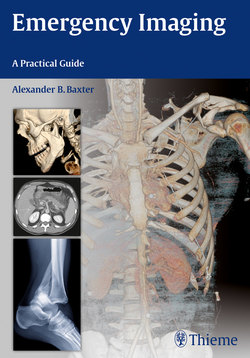Читать книгу Emergency Imaging - Alexander B. Baxter - Страница 12
На сайте Литреса книга снята с продажи.
Оглавлениеxiii
F
or
e
w
or
d
In the second year of radiology training, most residents across the United States start coverage in the emergency depart-ments (ED) of their institutions. It is ex-tremely common for the resident on this service to be busy giving initial readings, handling clinical and technical questions, filling out study protocols, and discussing and negotiating with other services over work-up decisions. For these novice radi-ologists beginning their emergency imag-ing training, it is a rather sudden jump into very cold water at the deep end of the pool, with a shark or two perhaps ramping up the anxiety.
ED imaging is a very demanding under-taking. A huge amount of information must be rapidly acquired before a resident can safely be released into this environment. Yes, there may be an attending radiolo-gist to consult, but most likely he or she is also in “survival mode” and may have little time to answer questions and perhaps only rare opportunities to provide formal teach-ing. The pace of work in the emergency department is uncontrollable, and there are time limits for many types of studies to be reported and finalized. Surrender is not an option; the resident-in-training has an awesome task to perform to stay afloat.
Thirty-three years ago, when I was a junior resident, coping with ED radiology was quite a bit less challenging. Chest and bone radiographs were by far the most fre-quent studies. CT was still uncommon; it was time consuming and used mainly for assessing the brain. Occasionally, a barium GI study, sonogram (B-mode), or nuclear-medicine scan would turn up for review. The interpretations were not checked un-til early the next morning, so I had a few
hours to verify my opinions, although with far fewer resources to consult than are available now. I even got three or four hours of sleep most nights. I thought I was working extremely hard, but today’s radi-ology residents work under greater time pressure, handle far more studies, have more and varied responsibilities, and need to know more.
The advent of fast and readily avail-able CT, and the general recognition that patients should receive equivalent medi-cal care anytime they arrive in the ED, prompted the introduction of in-house at-tending and resident-level coverage 24/7 to quickly provide imaging reports. CT, in particular, provided accurate diagnostic in-formation covering a far wider spectrum of diseases than was available before the ex-tensive deployment of CT. Comprehension of more detailed CT anatomy and recogni-tion of a greater variety of emergency pa-thology throughout the body was required. CT protocols had to be planned with great-er precision to acquire specific information targeted to particular diagnoses. CT devel-oped into the backbone of diagnosis in the ED, and its use has steadily increased given its wide range of applications, greater ac-curacy for diagnosis, and ready availability.
In recent years, MRI has also been used more frequently to answer diagnostic ques-tions where CT either has little or no role or to clarify and expand upon the informa-tion provided by CT. Knowledge of MRI ap-plications, protocols (sequences) required, and the appearance of various pathologies is increasingly necessary as MRI units are placed closer to or within the ED. Of course, radiographs remain the most frequently performed emergency imaging study. So-
